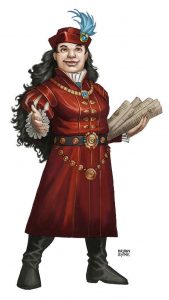
It’s Midgard Monday! Each week, we visit a corner of the wide world of Midgard. Look for standalone content you can drop into your campaign—whether it’s in Midgard or your own homebrew. Find new inspiration each Midgard Monday!
After the events of the last few months, many GMs and players are looking for alternatives to the world’s first roleplaying game. You might already be familiar with the 5E-compatible products offered by Kobold Press, like the three Tomes of Beasts and the city-builder book, Campaign Builder: Cities & Towns.
But did you know that Kobold Press has a vibrant, diverse campaign setting of its own, ready to be filled with heroic—dare I say valiant—tales and adventures?
This series focuses on the adventure locales in the Midgard Worldbook and the overlap with campaign settings you might already be using. In our last article, we focused on the Free City of Zobeck (and the amazing adventure/gazetteer that is Zobeck: Clockwork City Collector’s Edition). But there’s so much more to Midgard!
Classic High Fantasy in the Crossroads
Outside of Zobeck, three nations neighbor the Free City: the dwarven Ironcrags to the west, the Magdar Kingdom to the south, and the Duchy of Perunalia, perched along the Ruby Sea. These nations (along with the ancient Margreve Forest) form the Crossroads of Midgard—the heart of commerce throughout the lands.
- If you play in Greyhawk, you’ll find many similarities between the Crossroads and the Sheldomar Valley (including Keoland, Geoff, Gran March) as well as the Ulek States in the Lortmil Mountains.
- If you play in the Forgotten Realms, you can easily swap the Crossroads in for the Sword Coast. (The only thing you’re missing is the coast.)
The Ironcrags
The Ironcrags officially have thirteen subdivisions known as cantons, each a century old or more. Each canton has a mighty hall built into the mountain range that gives them the name. And each hall has forges and smelters where famous dwarven armor and weapons are crafted, as well as breweries and shrines to the gods. Most dwarves are trained in war and defend themselves from the monsters above and below the mountains.
Throughout the ages, many halls in the Ironcrags fell to invasion or were abandoned for reasons best left forgotten. These ruins are ripe for plunder by the bold and clever, willing to risk a decade as a thrall to the dwarves.
- In the Forgotten Realms, you could swap the Ironcrags for iconic locations like Citadel Felbarr, Mirabar, and Mithral Hall.
- In Eberron, the Ironroot Mountains and the Mror Holds are an obvious analog for the cantons. Similarly, the priests and smiths of the Ironcrags may wield similar power as the dragonmarked House Kundarak.
Magdar Kingdom
The rolling hills of the Madgar Kingdom provide little natural defense from invaders from the south and east. As such, chivalrous knights fortify castles that dot the country to deter smaller raiding parties, while the Widow Queen summons war wagons, allies, and mercenaries to Runkelstad, Cronepisht, and Khorsburg to repulse encroachers.
- If you play in the Forgotten Realms, you might recognize themes and tropes within the kingdom of Cormyr and its Purple Dragon Knights.
- If you play in Greyhawk, you’ll find many parallels to the Gran March, especially with the knightly Order of the March defending the Sheldomar Valley from threats from the Baklunish West.
Perunalia
Flanked by the River Argent to the north and the Gennecka Forest to the south, the Duchy of Perunalia rests along the Ruby Sea. This strong matriarchal society is ruled by Vasilika Soulay, the daughter of Perun, the god of war and thunder.
The Duchy is often besieged by hostile neighbors in the Ruby Despotate and the Dragon Empire. They rely on a strong culture of warfare and a strong friendship with the Free City of Zobeck.
- Strong matriarchies are not terribly common in most fantasy settings. (Feel free to tell me in the comments how wrong I am.)
- You may find commonalities between Perunalia and Evermeet (Forgotten Realms) and Aerenal (Eberron) as elven isles with unique cultures that periodically fend off invasions from their neighbors.
Ancient Dangers in the Margreve Forest
Just north of Zobeck is Margreve, an almost impossibly ancient forest. The Margreve existed in the youth of gods but remains untouched by the passage of time. Old magic lingers within the shade of its branches, and it’s rumored that great wealth and magical power can be found by those brave and skilled enough to snatch it.
Little is known about the interior of the Margreve, aside from oft specious trail maps carving through the forest. What is known is that the Margreve is wild and protected by animals and fauna. The trees seem to siphon magic, and iron rusts appreciably under its boughs.
- Certain forests in Faerun, such as the Yuirwood, the High Forest, and Neverwinter Wood, begin to approach the mystery, danger and antiquity of the Margreve Forest.
- While playing a “Points of Light” campaign, first popularized in 4E, the PCs visit villages, towns and other settlements isolated from each other by danger. The village of Levoca and the hamlet of Incot, both detailed in Tales of the Old Margreve, can help form the basis of a Points of Light campaign in the forest.
What’s Next?
At this point, we’ve barely scraped the bark on World Tree of Midgard. Next time, we’ll look at some major nations that are closer to the edge of the map.
Get into Midgard with the Midgard Worldbook! This acclaimed campaign setting is rich and deep, with a decade of support from Kobold Press.
Does a new setting feel like a big lift? Check out our intro article, Unpacking the Midgard Worldbook!
